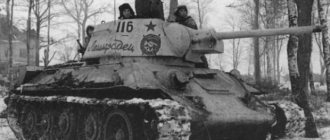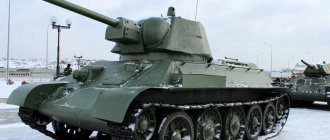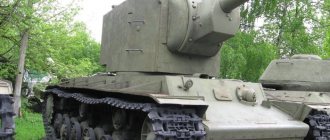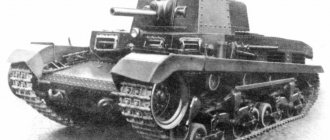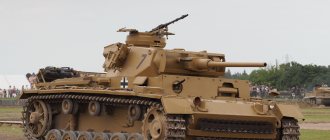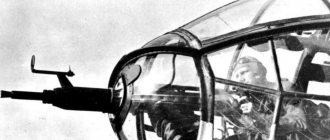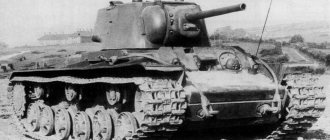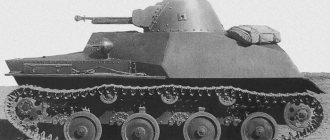The Soviet medium tank T-34 76 became the most important combat unit of the USSR during the Great Patriotic War, thanks to a large number of successful design solutions and discoveries.
Of course, one cannot say that the T-34 turned out to be an ideal machine, but the simplicity of its design, ease of repair and amazing unpretentiousness in battle made it possible to become a truly great weapon. Of course, not without the heroism of domestic tank crews, who often sacrificed themselves and showed miracles of the Russian spirit and ingenuity.
History of creation
In 1937, the Soviet leadership formulated general principles for building a new tank for the troops. The rapid development of anti-tank systems in the world played a leading role in the deep modernization of existing armored forces.
Lightly armored vehicles of the USSR - T-26 and BT-5 in the Spanish Civil War shortly before the bloody battles of World War II showed extremely weak qualities on the battlefield. They had frankly thin armor that could not even withstand hits from 37mm guns. Another danger was the use of gasoline engines, which emitted vapors that could easily ignite from the slightest spark.
Of course, the leadership of the USSR tried to take into account the mistakes of past projects, and immediately made a detailed technical specification for the new machine.
In 1938, it was decided to make prototypes (the projects were called A-20 and A-32) and test them.
In 1939, these tests started. It turned out that the A-32, with more armor than the A-20, as well as a 76mm cannon, has better performance. In addition, it had sufficient potential for further modernization.
By March 1940, it was ordered to produce two pre-production tanks, which were called the T-34 of the 1940 model. But there is another designation - T-34-76 - based on the caliber of the main gun.
The project was entrusted to the shoulders of the Kharkov Steam Locomotive Plant. The main designers were the famous domestic specialist Mikhail Ilyich Koshkin and Adolf Dick. The latter was later arrested due to a delay in completing technical documentation, so Koshkin continued the work.
The gun for the first two experimental tanks was developed by two factories: L-11 in Leningrad and F-32 in Gorky.
There was no difference in caliber, but the F-32 gun turned out to have a large (in length) barrel. We noticed this after assembly (it must be said that the edge of the barrel protruding beyond the nose armor led to the fact that the vehicle could rest against the ground when overcoming trenches and ditches). They did not change anything, so the first two samples had barrels of different lengths.
In February-March 1940, production samples were tested at a test site in the Kharkov region. And on March 6, the T-34-76 covered almost 750 km from Kharkov to Moscow in 6 days under its own power and off-road. Thus, management demonstrated the reliability of the new car (and accumulated the necessary mileage required for testing).
Higher officials noted such an extraordinary move, and on March 31, 1940, a decision was made to mass-produce the tank for the needs of the army. By the way, the cars got back to Kharkov the same way.
T-34 76 is a real symbol of the Great Patriotic War. Thanks to its excellent maneuverability, maneuverability and reliability, ease of assembly, the vehicle became the most popular tank during the years of conflict.
A difficult start to a glorious journey
The history of the Soviet T-34 tank is pages written with blood and sweat. Despite the fact that today, in most cases, the idea of a legendary tank is formed on the basis of the T-34-85 vehicle with a long and powerful gun, the vehicle of the very first modification bore the brunt of the battles of the Second World War. It was with this machine that the Red Army entered the Great Patriotic War. Until 1944, the main tank of the Red Army was the T-34-76. Soviet tank crews fought on these tanks in 1941 near Moscow and took part in the bloody battles near Stalingrad in the summer and winter of 1942. The T-34s of the first modification faced a lot of tests during the battle on the Kursk Bulge in 1943.
Soviet T-34s became the most popular tanks in the entire history of the war. From 1940 to 1947, the car in various modifications was produced in the USSR by 7 factories at once. Later, after the end of World War II, Soviet T-34-85 tanks began to be assembled at factories in Czechoslovakia and Poland. Before the war, the new car was mainly produced by the Stalingrad Tractor Plant, Kharkov Plant No. 75 and the Kirov Plant in Leningrad. Subsequently, with the beginning of the Great Patriotic War, Gorky, Omsk plant No. 174, a tank plant in Nizhny Tagil and plant No. 183 in Chelyabinsk joined the production of “thirty-fours”.
During the first period of the war, from the summer of 1941 to the summer of 1942, the Soviet tank industry experienced the most difficult period associated with the large-scale evacuation of enterprises to the East. New tank factories in Nizhny Tagil, Omsk and Gorky were just gaining the necessary capacity. Old Soviet tank factories in the European part of the country continued to operate in difficult front-line conditions. The Kirov plant in Leningrad continued to produce KV and T-34 tanks during the blockade. The Kharkov plant was lost as a result of the rapid German offensive in the spring of 1942. The Stalingrad Tractor Plant produced T-34 tanks so necessary for the front until the very last moment, when street battles were already taking place in the city.
Despite the difficult conditions at the front and the loss of main production facilities, Soviet troops continued to receive medium tanks.
In general, we can say that 1941 became a landmark year for the T-34 tank. The role of the “thirty-four” in the most difficult and difficult period for the Red Army can hardly be overestimated, even if in the first months of fighting at the front, up to 80% of the new vehicles available to the troops as of June 22, 1941 were lost.
The difficult situation with equipping Soviet troops with modern and combat-ready armored vehicles, which developed in the second half of 1941, inevitably affected the strength of the Red Army's defense. The enemy increased the strength of its attacks, using tank strike formations in the main directions. The Soviet troops could not oppose anything to this onslaught, due to the lack of the necessary number of modern and powerful tanks in the troops.
The Soviet tank industry did not have time to make up for the losses of armored vehicles in the troops; the defense industry in the east of the country was only gaining its capacity. In the battles near Moscow, the Soviet command used mainly old, obsolete light tanks BT-7 and T-26. The situation was slightly eased by the appearance of light tanks T-50 and T-60 at the front in small numbers. The share of modern Soviet tanks of the Second World War T-34 and KV in the troops after the devastating first months of 1941 was insignificant.
Only a year later, during the counteroffensive of Soviet troops near Stalingrad, the situation began to change for the better. The Soviet shock tank corps were equipped with the new “thirty-fours” in sufficient quantities. Beginning in the spring of 1942, Soviet tank crews began to receive brand new T 34s coming off the assembly lines of Ural factories. Already by the beginning of 1943, the Soviet tank industry in terms of tank production surpassed the results of the work of tank factories in Germany and occupied Europe. Soviet factories produced 15,889 T 34 tanks alone in 1943. Since 1944, production of a more advanced vehicle began, in which the turret was replaced and the main weapon was the 85-mm ZIS-S-53 cannon.
Design
The T-34 76 tank had a major influence on the course of the Second World War due to design solutions that were unique for its time. For the first time, a long-barreled gun was installed on a medium tank. This move made it possible to significantly exceed all analogues existing at that time in terms of initial projectile speed (612 m/sec) and, accordingly, penetrating force.
One of the main design moves in the T-34-76 is considered to be a surprisingly optimal combination of angles of inclination of the frontal and side armor.
Thanks to this, it was possible to increase the survivability of the tank. The diesel power plant, which produced 500 hp, helped to win a big design victory. (19.2 hp per ton of weight), which was an advanced indicator of that time.
Along with obvious advantages, the T-34 also had disadvantages. The design included little space for the crew. The tank commander and mechanic had poor visibility. And the hatch for the driver, located on the frontal armor, turned out to be a big design mistake, as it increased the vulnerability of the tank. No less problematic was the transmission, which often failed.
Often, due to the special rush in production (for obvious reasons, since the country was in a state of war), a lot of defects and outright defects left the factory. This also left an imprint on the overall reliability of the machine.
The layout of the tank was classic. The engine was located in the stern, and in the front there was a place for the driver and radio operator. The tank commander's position was in the turret, to the left of the gun. He served as a gunner. The loader was located to the right of the gun. In total, the vehicle crew included 4 people.
The bow of the tank hull was protected by 45 mm armor.
A periscope viewing device was installed on the driver's hatch. The course machine gun was protected by an armored cap. The entire body was made of eight rolled armored sheets welded together. Six of them were mounted at different slopes to the vertical (frontal - 53° and 60° to the horizon, side top - 40°, rear - 45° and 47°). And only the side lower armor was made strictly vertical.
The rear and side armor was 40 mm thick. Later it was strengthened, making it 5 mm thicker. The upper part of the hull under the turret varied in thickness from 16 to 20 mm. Bottom – 13 mm.
The cast turret of a tank, which is ingrained in the minds of the average person, does not correspond to reality. Turrets were cast only for heavy tanks, such as the KV1 and IS-2, and there were few of them.
For the T-34-76, a welded turret was made from rolled armor plates. In the upper part there was a hatch for the crew, as well as a ventilation hole and a PT-6 periscope sight. The side and rear sheets were installed at an angle of 30°. The rear part was protected by a removable armor panel, which was necessary for replacing and repairing the gun. The thickness of the frontal armor of the turret was 45 mm.
The tank received five pairs of road wheels. The drive wheels were located at the rear. Small-link caterpillars were made using the same technology as for the BT tank. However, the width exceeded the prototype and reached 550 mm.
The tank received a 76 mm L-11 gun with a barrel length of 2.32 meters.
The gun's ammunition load was 77 rounds, and for the most popular models of 1942-1944 it was expanded to 100 rounds (thanks to the optimization of stowage technology). The gun was mounted on trunnions in the front of the turret, paired with a 7.62 mm DT machine gun (the same was in the bow of the hull).
The supply of ammunition for machine guns was 2898 or 3087 pieces (and on models without a radio station it reached 4725 pieces).
Introduction
T-34 tank: the best Soviet tank, history of creation, characteristics
After the end of the Civil War, a period of diplomatic recognition of the young state began. Our country was faced with the task of restoring the economy destroyed by the war and starting peaceful construction. At the beginning of 1921, an acute internal political crisis arose in Russia, caused by the discontent of the peasantry with surplus appropriation. It resulted in uprisings of the peasant masses in a number of provinces, in particular in Tambov, where peasant unrest was called the Antonovshchina.
Under pressure from the broad peasant masses who demanded the introduction of a solid tax in kind instead of surplus appropriation, as well as in connection with the obvious failure of the policy of “war communism,” the leadership of the RSFSR adopted at the Tenth Congress of the RCP (b) in 1921 a course towards the so-called “new economic policy”, which provided for the abolition of surplus appropriation and the distribution system, allowed the existence of a private sector in agriculture and industry, leasing of enterprises, foreign concessions in the field of mining, free trade and the use of hired labor. This made it possible to fill the market with goods in the shortest possible time and solve many of the country’s economic problems, especially food.
With the change in the political situation both within the country and in the international arena, the functions of the Cheka changed accordingly. In particular, the need to use emergency measures, which the Cheka resorted to during the Civil War, disappeared. Therefore, on January 23, 1922, a decision was made to abolish the Cheka and create on its basis the State Political Administration (GPU) under the People's Commissariat of Internal Affairs.
In December 1922, the Soviet Union was created, which united almost most of the former territory of the Russian Empire into a single state. After the formation of the USSR, the GPU was transformed into the United State Administration (OGPU).
This reorganization was not a simple sign change. Unlike the former Cheka, which had the right to make extrajudicial sentences, the OGPU was engaged in solving political problems. And all issues related to the scope of justice were resolved through the prosecutor’s office and the court.
Technical characteristics of the T-34 76 in comparison with analogues
Of course, the main opponents of the T-34 76 on the battlefield were German tanks. The most massive of them are the medium T-III and T-IV. The American Sherman is considered very similar to the Soviet tank, but with a number of its own solutions.
| T-34 76 | Pz.Kpfw.IIIAusf.J | Pz.Kpfw.IVAusf.F2 | M4A2 Sherman | |
| Length, m | 5,92 | 5,495 | 5,89 | 5,918 |
| Width, m | 3 | 2,95 | 2,88 | 2,616 |
| Height, m | 2,41 | 2,5 | 2,5 | 2,68 2,743 |
| Weight, t | 25,6 | 21,6 | 23,6 | 31,87 |
| Frontal armor, mm | 45, later versions – 52 | 30+20 | 50 | 51 |
| Armament | 76 mm cannon and 2 DT machine guns, 7.62 mm | 50 mm cannon and 2 Mg-347.92 mm machine guns | 75 mm cannon and 2 machine guns Mg-34, 7.92 | 76 mm cannon, 1 12.7 mm machine gun and 2 7.62 mm machine guns |
| Engine, power, hp | 500 | 285 | 250 | 375 |
| Maximum speed, km/h | 55 | 40 | 40 | 48 |
| Travel range, km | 300 | 155 | 210 | 241 |
| Crew, people | 4 | 5 | 5 | 5 |
Both domestic and foreign experts consider the main trump card of the T-34 to be a successful gun, which was distinguished by an optimal combination of reliability, penetrating power and rate of fire.
Also, the Soviet vehicle had favorable dimensions and less armor than its analogues, which is why it remained maneuverable on the battlefield. The engine deserved good words, which, due to its efficiency and traction, allowed it to reach high speeds.
The main disadvantages of the machine
The main disadvantage was its high weight and width, which made it impossible to transport the tank on conventional railway platforms without prior preparation. As for comparing the angular armor of the Tiger and Panther with rational viewing angles, in practice the T-6 still turned out to be a more formidable opponent for Soviet and allied tanks due to more rational armor. The T-5 had a very well protected frontal projection, but the sides and rear were practically bare.
What’s much worse is that the power of even two engines was not enough to move such a heavy vehicle over rough terrain. On marshy soils it is simply an elm. The Americans even developed a special tactic to fight against the Tigers: they forced the Germans to transfer heavy battalions from one sector of the front to another, as a result of which after a couple of weeks half of the T-6s (at least) were under repair.
Despite all the shortcomings, the German Tiger tank, a photo of which is in the article, was a very formidable combat vehicle. Perhaps, from an economic point of view, it was not cheap, but the tankers themselves, including ours, who tested captured equipment, rated this “cat” very highly.
Modifications and combat use
T-34-76 were produced until 1944. A total of 35,330 vehicles of the 1940 model were assembled. Self-propelled artillery units SU-122 and SU-85 were also made on their basis.
Of course, the main use of the T-34 unfolded during the Great Patriotic War. At the time of the outbreak of hostilities, there were 1,225 units in the army. During the war, production was reoriented to Chelyabinsk and Sverdlovsk (now Yekaterinburg). One of the most important achievements of the Soviet Union, which may have played a key role in the victory, was the mass production of the T-34 76.
The tank fought its main battle at the Kursk Bulge, where about 6,000 tanks took part on both sides.
The machine became legendary because it met the basic requirements of the time and was not distinguished by its design complexity. However, the tank itself without a crew is a piece of iron. The dedication of our tank crews who used the technical characteristics of the T-34-76 made it one of the symbols of mankind’s most terrible war.
How much does the T-90 tank weigh?
The model is an improved version of the T-72 tank. It has high combat and technical characteristics that allow it to withstand battles in any climatic conditions.
The weight of the T-90 tank is 46.5 tons.
The weight of the T-90 tank is 46.5 tons. The combat vehicle is equipped with a 125-mm launcher designed to hit targets of all types, as well as an sighting system and a thermal imager. The tank has a high rate of fire, excellent speed (60 km), and the crew includes three people.
Kunai - paper knife
Kunai made of paper are absolutely safe. They can complement your look or simply add to your collection. So, this is paper origami - the weapon of the modern ninja, kunai. It's easy and quick to do, and looks like a real knife.
Take a square piece of paper and fold it diagonally. You will get a right triangle. It needs to be folded in half. The figure unfolds to its original position, then each corner is folded so that the edge is level with the center fold line. The figure is again folded in half along the center line.
The ends of the paper need to be tucked into the resulting “pocket” on one side of the figure. We get the tip of the dagger.
Now you need another sheet of paper. It needs to be twisted into a thin tube and pushed into the “pocket” about ¾ of the way. The remaining part of the tube is smoothed out. Now you need to form the tip of the handle. The second end of the tube is bent four times at an angle of 90 degrees. The tip must either be tucked into the first fold or secured with a drop of glue. We get ninja weapons made using origami technique. It can be used for cosplay or just for playing.
SS officers
Let's consider the features of the officer corps. The SS Hauptsturmführer and lower ranks no longer had oak leaves on their buttonholes. Also on their right buttonhole was the SS coat of arms - a Nordic symbol of two lightning bolts.
Hierarchy of SS officers:
| SS rank | Lapels | Compliance in the military |
| SS Oberführer | Double oak leaf | No match |
| Standartenführer SS | Single sheet | Colonel |
| SS Obersturmbannführer | 4 stars and two rows of aluminum thread | Lieutenant colonel |
| SS Sturmbannführer | 4 stars | Major |
| SS Hauptsturmführer | 3 stars and 4 rows of thread | Hauptmann |
| SS Obersturmführer | 3 stars and 2 rows | Chief Lieutenant |
| SS Untersturmführer | 3 stars | Lieutenant |
I would like to immediately note that the German stars did not resemble the five-pointed Soviet ones - they were four-pointed, rather reminiscent of squares or rhombuses. Next in the hierarchy are the SS non-commissioned officer ranks in the Third Reich. More details about them in the next paragraph.
